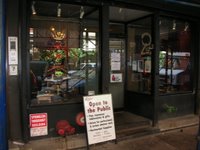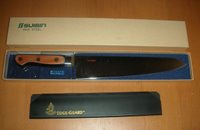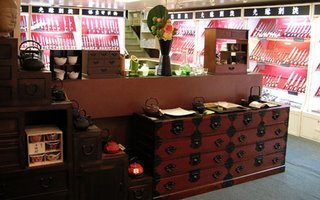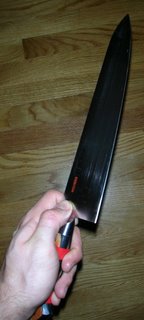KORIN: A KID IN A CANDY STORE
 Today I finally visited Korin, a Japanese knife store a few blocks from Chambers Street on Warren Street between Church and West Broadway. The window has a samurai suit in it and you have to ring the buzzer for the people inside to unlock the door and let you in. When the door opens, you see why. It's a candy store for anyone interested in kitchen tools-- knives that is.
Today I finally visited Korin, a Japanese knife store a few blocks from Chambers Street on Warren Street between Church and West Broadway. The window has a samurai suit in it and you have to ring the buzzer for the people inside to unlock the door and let you in. When the door opens, you see why. It's a candy store for anyone interested in kitchen tools-- knives that is. Back at the end of May I was very excited to buy a new knife, a 9 1/2 inch Suisin Inox Western Style Knife I thought I deserved for passing my midterm at the French Culinary Institute and graduating from Level Two to Level Three. It is a beautiful, light knife with a razor-sharp edge.
Back at the end of May I was very excited to buy a new knife, a 9 1/2 inch Suisin Inox Western Style Knife I thought I deserved for passing my midterm at the French Culinary Institute and graduating from Level Two to Level Three. It is a beautiful, light knife with a razor-sharp edge.I spent about $120 on it at the Broadway Panhandler and it was there that the fellow behind the counter explained to me that my Suisin had a 70 to 30 edge, meaning that the two edges of the knife weren't the same angle, that the knife was sharpened in a more sophisticated way than your run of the mill standard issue knife. While he couldn't explain exactly how to sharpen it, he was the first to tell me of a Korin, a Japanese knife store he said gave demos about how to sharpen Japanese knives.
Well, this all should have been enough to clue me into the fact that I should have gone directly to Korin to buy my knife but I've always learned the hard way. In fact, I wasn't very well educated about my knife and what it could be used for-- it wasn't explained to me that the knife wasn't suited for butchering chicken or that at least care needed to be taken when cuting off the end of chicken bones (manchonner).
As a result, the knife was scarred with two slight bevels in the edge. They were blemishes like the first smudges on a brand new pair of white sneakers or the first nick on the door of your car but there was nothing to do but press forward. The knife still had a far better edge than our standard issue ones. I just stopped using it for the hard stuff-- meat, vegetables sure, bone...no way. The thing about Japanese knives, especially those with 70/30 edges is that supposedly they keep their sharp edges much longer. Mine didn't disappoint-- for almost two months I didn't have to think about sharpening it (though I should have been). But I'd noticed lately that the knife was stalling on tomato skins and I hoped that the people at Korin could teach me how to sharpen it and buy the right tool their with which to hone the edge.
 As I noted above, Korin is a candy store (store pix left & below c/o www.korin.com). Look around at the Japanese knives in the display cases around you. Light knives, long knives, thin knives, sharp knives, knives with thick tops and razor thin eges, knives that you'd be scared to use for fear of making a mistake and very easily making a cut in your hand you never wanted to see.
As I noted above, Korin is a candy store (store pix left & below c/o www.korin.com). Look around at the Japanese knives in the display cases around you. Light knives, long knives, thin knives, sharp knives, knives with thick tops and razor thin eges, knives that you'd be scared to use for fear of making a mistake and very easily making a cut in your hand you never wanted to see.Beautiful handles and blades like you've never seen, the results of the samurai sword tradition being distilled into kitchen weapons used to do loving battle with food.
 Started by a Japanese woman, Saori Kawano, the elegant Korin has been located in New York since 1982. At the back of the store, co-founder, Chiharu Sugai dressed in gray, Japanese robes demonstrated to a customer how to sharpen a long, thin Japanese knife. He sat at on a chair, a wooden apparatus in front of him on which a wet, smooth stone was placed. Mr. Kawano seemed to rub the knife with great ease across the surface of the stone and I recalled Chef Harold Dieterle sharpening his Shun knife with a similar stone he kept in a tattered, Japanese box after he finished sharpening his knives when I volunteered to work for him at the Tribeca Grill.
Started by a Japanese woman, Saori Kawano, the elegant Korin has been located in New York since 1982. At the back of the store, co-founder, Chiharu Sugai dressed in gray, Japanese robes demonstrated to a customer how to sharpen a long, thin Japanese knife. He sat at on a chair, a wooden apparatus in front of him on which a wet, smooth stone was placed. Mr. Kawano seemed to rub the knife with great ease across the surface of the stone and I recalled Chef Harold Dieterle sharpening his Shun knife with a similar stone he kept in a tattered, Japanese box after he finished sharpening his knives when I volunteered to work for him at the Tribeca Grill.When Mr. Kawano was finished I caught his attention and asked him about saving the edge of my knife where I'd dented it with the hard chicken bones. I can't say he was very approving of my situation. I explained what happened and he disappeared in the back of the store. Less than two minutes later he returned to show me my knife. That horrible pit-of-your-stomach feeling you get when you smudge the sneaker or find your car door knicked, you think you forget about it, get used to it at least, well, if it gets removed suddenly, free of charge, let me tell you, a weight lifts off, you can still carry that baby! Usually, they charge for this kind of repair but they fixed the knife for me for free.
And Mr Kawano gave me a demo explaining how to sharpen my knife, including making me duplicate the angle and feel of the right and wrong angle of the knife on the wet stone. The exact kind of kinesthetic experience I usually need to learn.
 Every day after using the knife, he explained it should be sharpened on the fine stone, what they call the x6000. The stone needs to soak in water for 10 minutes before sharpening. Then the knife is placed on the stone and its angle followed. It sounds very zen, I know, but it seemed to make sense. The knife is held on the stone on the angle edge that it already naturally follows and then is rubbed for about 10-20 seconds back and forth, from the bottom to the top, almost pressed on the very wet stone so that a slight mud forms on top of it from the sediment that comes off of it. The stone almost looks like rubber.
Every day after using the knife, he explained it should be sharpened on the fine stone, what they call the x6000. The stone needs to soak in water for 10 minutes before sharpening. Then the knife is placed on the stone and its angle followed. It sounds very zen, I know, but it seemed to make sense. The knife is held on the stone on the angle edge that it already naturally follows and then is rubbed for about 10-20 seconds back and forth, from the bottom to the top, almost pressed on the very wet stone so that a slight mud forms on top of it from the sediment that comes off of it. The stone almost looks like rubber.While not necessarily at a ratio of 7:3, Mr. Sawano said that the knife shouldn't be sharpened equally on each side. I'd just as much assume keep the 7:3 ratio. To recap:
- Knife should be sharpened every day used on fine stone (x6000)
- Each fine-stone sharpening should be a slightly altered angle, rising to then return to the beginning angle.
- The knife should be sharpened for a right-handed person more on the right side than on the left side.
- Every 3 or 4 days the knife should be sharpened first on the fine stone and then on the medium stone (x1000)
The instructions that came with the stone further explained:
" Just before you are ready to change stones (e.g. from a 1200x to 6000x) let the slurry build up and reduced the pressure on the tool. This slows the abrasion rate because the build-up contains smaller, broken abrasive particles and the reduced pressure further reduces the depth of abraision. When you switch to the finer stone, you will achieve the desired finish fater.
Once again, as you approach the end of the process on the second stone, reduce the pressure and allow a slight build-up of slurry. The resultant edge will be better."
The instructions continued to advise:
"Japanese water stones tend to wear faster than oil stones - in fact this is the secret of their rapid cutting rate. Be sure to keep your stone flat. To promote even wear, use the full surface of the stone and occasionally change the stone end for end. To true a water stone, several methods are available. A fine stone can be trued by rubbing it against a coarser one. The coarser stone should first be trued on wet-dry sandpaper laid on any trued surface such as a piece of plate glass or a machined bed. 220x wet-dry paper works well.
...Caution: Do not allow your water stones to freeze when they are wet. They will fracture."
 Mr. Sawano advised that the knife could be used for bones but needed to be used in this way with great care, not forced. I was too rough with it before, he explained. I thanked him, paid for the stone, learned that there was a 15% discount on all knives through the end of the month, reminded myself that I don't have a job yet and was on my way to school, nickless-knife in my bag, razor-sharp and ready for tomato skins and eggplant caviar, a kitchen warrior ready for battle.
Mr. Sawano advised that the knife could be used for bones but needed to be used in this way with great care, not forced. I was too rough with it before, he explained. I thanked him, paid for the stone, learned that there was a 15% discount on all knives through the end of the month, reminded myself that I don't have a job yet and was on my way to school, nickless-knife in my bag, razor-sharp and ready for tomato skins and eggplant caviar, a kitchen warrior ready for battle.





0 Comments:
Post a Comment
<< Home